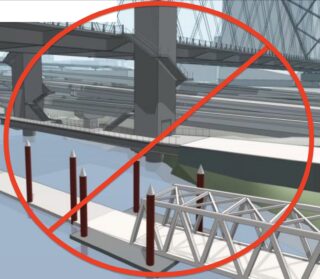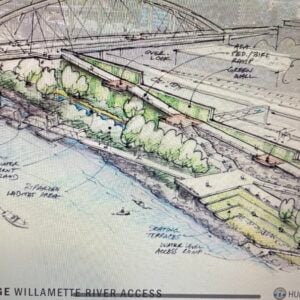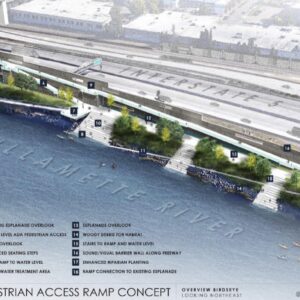“We are keeping [the stairs/elevator option] on the menu for the design phase, but it’s safe to say it has no supporters.”
— Mike Pullen, Multnomah County
Advocates lining up to testify at today’s Portland City Council meeting that includes an agenda item about the Earthquake Ready Burnside Bridge Project might want to edit their remarks.
We’ve just confirmed that Multnomah County has decided to postpone a decision about whether there should be an elevator and stairs or a ramp to connect the new bridge to the Eastbank Esplanade.
As we’ve reported, there’s been a slowly boiling debate between the project team and accessibility advocates about the future of this crucial connection. A ramp is considered imperative by bicycling advocates and was strongly favored by disability advocates because elevators are unreliable and it’s very difficult (and often impossible) to carry a bike or mobility device up 50-feet of stairs. The elevator problem has plagued agencies like TriMet and Portland Bureau of Transportation for years now, with outages effectively cutting off vital crossings like the new Bob Stacey Overcrossing and the Gibbs Street pedestrian bridge under the aerial tram. Covid supply chain delays and a lack of qualified repair technicians has exacerbated the issue recently.
Advertisement
“This is a step in the right direction.”
— Willie Levenson, Human Access Project
Elevator concerns are one reason why, when the County published their Draft Environmental Impact Statement (EIS) for the Burnside Bridge project earlier this year, they included an intention to study a ramp. A few months later, they received the bad news that — due to pandemic-related price spikes in materials — they’d have to cut about $200 million off the price tag of the $1 billion project in order to make it competitive for federal grants. They considered a stair/elevator option because their estimates said it would be about half as expensive as a ramp ($7-10 million compared to $15-20 million respectively). The stair/elevator option was on track to be included in the Supplemental DEIS that’s due in April 2022.
But as the project team shopped around the elevator idea, they realized it was very unpopular with stakeholder groups and the public. Reached for comment today, Multnomah County spokesman Mike Pullen said, “Since the spring, our outreach has determined that initial support for the stair/elevator option has faded to the point where no stakeholder group prefers it.”
Pullen said initial outreach revealed people were open to elevators, as long as they could be assured they’d remain safe, clean and reliable. But a few months later, the tenor of feedback — particularly from people with disabilities — changed: “… partly because PBOT staff raised a lot of concerns about the elevators based on their experience with outdoor elevators. The more that people thought about the choices, the more they decided that ramps were better… So the public feedback really did evolve,” Pullen said.
In addition to the negative public feedback, the County saw the City of Portland invest in a ramp as part of a feasibility study for a new park on the Esplanade envisioned by Human Access Project (HAP). “We are hearing a lot of people seek support from the City for a ramp that helps activate the Esplanade,” Pullen shared with me today. That’s good news for HAP’s leader Willie Levenson, who sees a ramp as a must-have for a more vibrant Willamette River. Asked for comment today, he shared, “This is a step in the right direction.”
Given these changes, the County will postpone the decision on the Esplanade connection until the project reaches its design phase, which is set to begin in late 2022. This delay will give the City of Portland (who has jurisdiction over the ramp and Esplanade) time to study the HAP proposal and other ramp designs to clarify the costs, benefits, and other impacts. The additional year will also give the County time to find more money to help pay for it.
So is the stair/elevator option dead? Pullen says no. “We are keeping it on the menu for the design phase, but it’s safe to say it has no supporters and it’s main positive is that it is the lowest cost connection that is ADA compliant.”







Thanks for reading.
BikePortland has served this community with independent community journalism since 2005. We rely on subscriptions from readers like you to survive. Your financial support is vital in keeping this valuable resource alive and well.
Please subscribe today to strengthen and expand our work.
Presumably the design of the ramp or elevator + stairs has to conform to the bridge design, so delaying this decision until the bridge layout is clearer makes sense.
Those of us who care about this decision need to keep pushing in the meantime. And finding some sources of $ to fund the park + ramp.
In other news, I noticed this morning that the elevator at Gideon crossing is out again. For reasons that I just don’t understand, PBOT cannot keep their elevators running. Perhaps they should take that into consideration on this project.